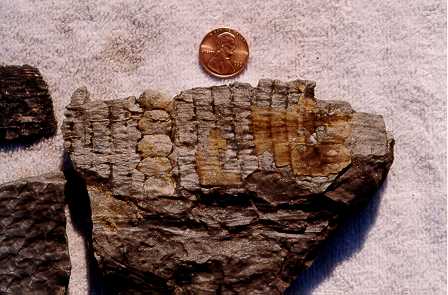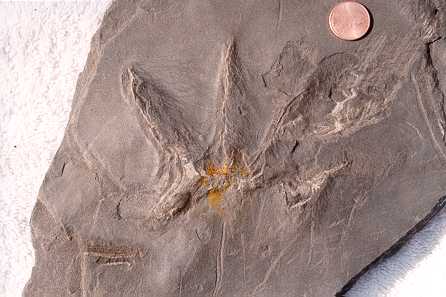On this first field trip of the first year of the new millennium (or the last year of the old millennium), the BPS had the pleasure of visiting a truly interesting surface mine in Walker County. The Union Chapel Mine is smaller than the Cedrum Mine we visited last month, but is located in the same general area. The field trip was attended by 11 "diehards" who were not put off by the weather, which started out rainy and cold. By the time we arrived at the site (about 9am), the rain had completely subsided and we were virtually rain-free the whole time we were there. However, the clouds persisted and the day was a little gloomy.
The trip was arranged by Ashley Allen, who heard about the site through his science class. The site proved particularly rich in tracks of amphibians and probably arthropods from the lower Pennsylvanian subdivsion of the Carboniferous Period. The tracks are trace fossils of the footprints of the creatures, and it is clear from the variety of tracks we all found that many different species of creatures are represented. According to Jim Lacefield, track fossils are found at most of the lower Pennsylvanian sites in Alabama, but often they are not as obvious or as richly abundant and diverse as they are at Union Chapel Mine. Like Cedrum and other Pennsylvanian sites the BPS has visited the past year, Union Chapel Mine is also rich in plant fossils. Jim has told me that the mix of other fossils with the usual plants reflects more the environmental differences between sites, rather than significant age differences. |
 |
| Fig. 2 - One of the rock piles at the site that was rich in tracks. |
| The following pictures show a few of the track fossils found. These range from some fairly large tracks (a few centimeters per print) to smaller prints that look like Chinese characters, and finally to really small prints that are at most a couple of millimeters or less in size. Some tracks also included obvious tail dragging marks. These can straight or curved, and I recall that Ashley found a particularly wavy specimen. Virtually everyone who was there found one or more interesting track fossils. |  |
| Fig. 3 - Excellent amphibian tracks held by Matthew Valente. |
 |
| Fig. 4 - Tracks resembling Chinese characters. |
 |
| Fig. 5 - Two sets of small tracks, with likely tail dragging marks. |
 |
| Fig. 6 - Inverse tracks of unknown creature. |
| Probably the most spectacular prints from the site were a huge set found by Jim Lacefield, the "likes of which I had never seen", according to Jim. Jim relates the following:
"The handprints, which include long, curving toes with easily-distinguished pads on the tips, are nearly as big as my own. This was a huge beast. Although I had read that some amphibians reached rather large size in the Pennsylvanian, in all my collecting in Coal Age rocks I have never seen any that were anywhere nearly this large." A digital photo of Jim's specimen is shown here. |
 |
| Fig. 7 - Monster tracks found by Jim Lacefield, in an image prepared for inclusion in his book. |
Although the track fossils were superb, and were the principal things we all searched for, the plant fossils were also quite impressive and ranked as my favorites. Bark impressions of Lepidophloios, a subgenus of the Lepidodendrales, were especially abundant at this site. Jim Lacefield was seeing so much Lepidophloios that he was wondering if there was any Lepidodendron. However, both Sigillaria and Lepidodendron were well represented at the site. I show specimens of Sigillaria and a genus related to Lepidodendron here. By far the most beautiful of any specimens I have seen, at Union Chapel or any other site, were the compressed cast fossils of two branches of a Sigillaria species. The leaf scars are small hexagons with a central spot, and are so well-preserved that even fine ridge-like details are seen. I spent 45 minutes hammering on a large rock to get pieces of these branches out. On the same rock was an especially beautiful species that looks at first like a Lepidodendron, with pieces of highly compressed cast fossils lying about. According to Jim Lacefield, this might be a representative of a related genus called Diaphorodendron. |
 |
| Fig. 9 - Close-up of Sigillaria specimen |
 |
| Fig. 10 - Bark impression of a likely Diaphorodendron, a genus related to Lepidodendron. |
| Other items of interest were a snail fossil found by Kathy Twieg, a large Lepidophloios cast found by Ashley Allen, a rhizome of Calamites by Jim Lacefield, myself, and others, a small medullary cast of Calamites found by Bruce Relihan, and a gigantic lycopod stump (probably weighing more than 800 pounds) noticed by Jim Lacefield Jim also showed me a likely trace fossil of a hermit crab and also tiny insect prints. Concerning the rhizome of Calamites, Jim gave me the following comments: "Calamites, like all horsetails, propogates vegetatively through spreading by underground stems called rhizomes. New Calamites stems sprout upward from these horizontal, underground stems. It's a type of asexual reproduction that allows them to spread quickly into new territory and also anchors them firmly in the unstable ground along rivers and out onto newly deposited delta sediments. Those round structures were clusters of cells that, under the right conditions, could develop into new Calamites shoots. The rhizomes of Calamites look quite similar to the stems in most cases, but have nodes that get progressively closer together as they get out approach the apical area (the growth tip that spreads outward through the soil. | |
 |
|
| Fig. 11 - Part of a rhizome of Calamites , showing characteristic round features that are not normally seen on calamites branch casts. |
 |
| Fig. 12 - Huge stump cast fossil, probably 800 pounds in weight, probably of a lycopod. |
There is no question that Union Chapel Mine has been one of the most interesting fossil sites that the BPS has had the privilege of visiting. According to Ashley, the Union Chapel Site will be reclaimed very soon. Since our original visit, various subgroups of BPS members have been back to the site, trying to salvage as many tracks and other items as possible before the site is gone.
Additional Pictures from Union Chapel Mine
The following pictures provide more examples of the types of fossils found at the Union Chapel Mine. In the two weeks after the January 23 field trip, several of us returned to the site. These are some of the items found on these return trips.
 |
| Fig. 1 - Stump cast of a Lepidophloios arborescent lycopod. Jim Lacefield and I were exploring one of the popular track rock piles at the site, and he pointed out this excellent stump cast to me. The piece weighs close to 300 lbs, but fortunately it lay on a slope that was accessible by my truck. All one could do is move the thing downhill. I rolled it down about 25 feet of slope onto a dirt embankment, and then with help moved it into my truck. It is pictured in my backyard garden area. |
 |
| Fig. 2 - this is a different view of the same stump cast, showing the large indentation that seems to characterize the shape of the trunks of these trees. In the January 23 report, I show a picture of an 800 lb stump with a similar indentation. |
 |
| Fig. 3 - this piece shows two criss-crossing tracks from small creatures with no tail-dragging marks. |
 |
| Fig. 4 - two sets of small tracks with distinct tail-dragging marks. |
 |
| Fig. 5 - complex inverse tracks of a still different creature, with only a weak tail dragging mark. |
 |
| Fig. 6 - a single large inverse print of what must have been a massive creature. This could have been a type of Attenosaurus, although the print is really different from those shown in Museum paper No. 9 of the Alabama Museum of Natural History, by Aldrich and Jones, published in 1930. |
 |
| Fig. 7 - excellent set of small inverse prints with a weak tail-dragging mark. |
 |
| Fig. 8 - another lycopod stump, this time covered with excellent leaf scars on side facing camera. Weighs about 200 lbs |
 |
| Fig. 9 - three sets of small prints, found on a "page" of a vertically standing rock that opened into many layers. |
 |
| Fig. 10 - a set of tracks, nearly 2 feet long, found by Jim Lacefield. Jim believes these are fossil tracks of a horseshoe crab. The actual crabs were not in the original photo! |
 |
| Fig. 11 - Jim also found this rock with excellent fossils of lycopod branches. Details are present at various levels and the branching is complex. |


